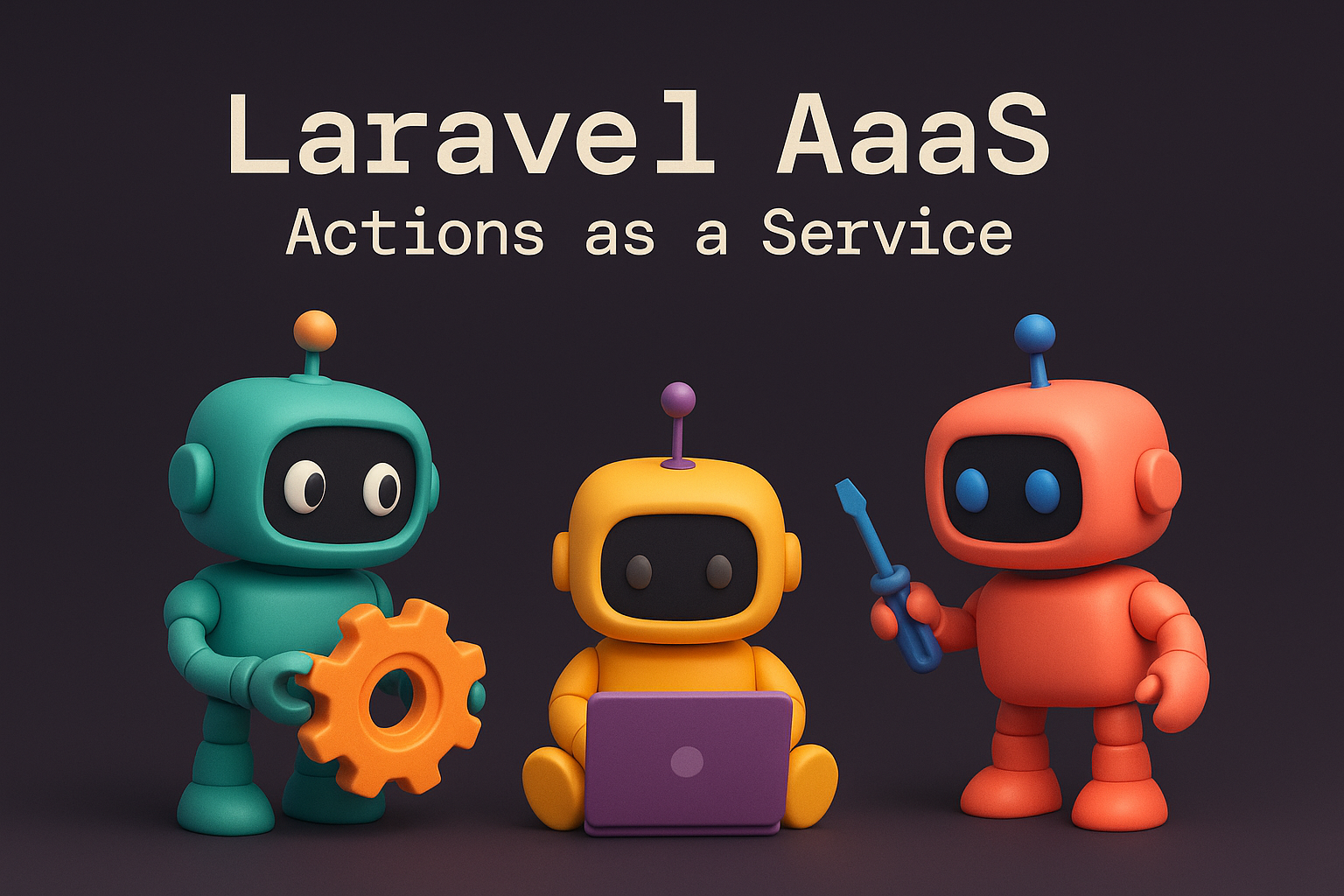Introduction
Laravel is an amazing framework. We can build products really quick with all the features and DX it provides. Usually there are many ways to do things in Laravel, there's no single correct way of doing it, and sometimes it's really down to a personal level on how we want to structure our applications.
Action classes and Invokable Controllers are a hot topic nowadays. I see a lot of people using and talking about them. I also used and experimented with these ideas, and in this article I'm going to explain why I think that Invokable Controllers are a bad idea and about an Architectural Pattern I created and I've been using that I named AaaS - Actions as a Service.
Again, as I said before, there are many ways to do things in Laravel and I'm going to show you one of those. I like it, and it makes sense to me to organize my applications like this, but if it doesn't make sense to you, you're free to organize your applications in your way.
Action Classes
Action classes are classes with the purpose of executing a single action. They are classes with usually a single (public) method. A really simple example of an Action class would be for creating a new user.
namespace App\Actions\Users\CreateUser;
use App\Models\User;
class CreateUser
{
/**
* @param string $name
* @param string $email
* @return User
*/
function handle(string $name, string $email): User
{
User::query()->create([
'name' => $name,
'email' => $email,
]);
}
}
As you can see in the above (simplified) implementation, the class CreateUser is only used for creating a new
User. In a real code you probably will have more logic in this class, and it can even have other private methods
for splitting the logic in a more readable and maintainable way, but the idea is to have a class that has a
single purpose.
Invokable Controllers
The concept of Action classes are usually largely used for creating Invokable Controllers that are
Controller classes with the purpose of executing a single action. So instead of having multiple methods
in it, the Controller will have only an __invoke() method defined and that's what's going to be executed.
Let's see the above Action example implemented as an Invokable Controller.
namespace App\Http\Controllers\Users;
use App\Http\Controllers\Controller;
use App\Http\Requests\Users\CreateUserRequest;
use App\Models\User;
class CreateUserController extends Controller
{
/**
* @param CreateUserRequest $request
* @return User
*/
function __invoke(CreateUserRequest $request): User
{
$data = $request->validated();
User::query()->create([
'name' => $data['name'],
'email' => $data['email'],
]);
}
}
Why Invokable Controllers are BAD
Invokable Controllers are a hot topic right now in Laravel and this concept is being used heavily by a lot of developers. Personally I think it's BAD. I'm not criticizing people that use it, if this works for your application, continue doing that, but I'll explain why I don't use it.
As far as I saw, the developers using Invokable Controllers use it to avoid having huge Controllers. I totally get it, but IMO the controllers shouldn't be huge even if they have multiple methods. In fact, I've been working with APIs on Laravel daily for the past 5 years and all my Controller methods have at max 5 lines of code and that's because I use the Controllers only as a Communication Layer as I talked about in this article. So to me, it doesn't make sense to create a file that will have only a few lines of code. IMO the Controllers should only be used to:
- Get the Request
- Map the input properties
- Send the mapped input to the Service Layer
- Get the result from the Service Layer and send back a Response
The AaaS Pattern
I really liked the idea of Action classes, but as I mentioned above, to me, it didn't make sense to implement it as Invokable Controllers. So I've been using Action classes in a different way. I've been using them as my Service Layer, and that's how I named this pattern AaaS - Actions as a Service.
This is an Architectural Pattern like MVC and even that I created this because of Laravel, you can apply it to other frameworks and even other programming languages if you want to. This pattern have four principles that I'll explain below.
Thin Communication Layer
The Communication Layer is the layer of our applications that receives the user input. In a Web app this is our Controllers, in a CLI app it's the Commands. This layer should only:
- Get the input from the user
- Map the input properties
- Send the mapped input to the Service Layer
- Get the result from the Service Layer and send it back to the user
Detached Validation
The data validation should NOT be tied to the Communication Layer. It means that the data validation should be tied to the data itself or to the Action it's used to accomplish. In a Laravel application it means that the data validation should NOT be done using Request Forms per example, but in a DTO or in the Action itself.
Mapped Input
The input needed to execute an Action should be mapped into a DTO (Data Transfer Object) when it needs multiple input properties to improve the code quality and maintainability of the Actions of the application.
Single Purpose Actions
All the Business Logic of the application should be in Action classes and each Action class should be responsible for a single Action. You can call another Action in an Action if needed, to avoid code duplication.
How to Implement the AaaS Pattern
Now that you know what's the AaaS Pattern, let's see a simple example on how to apply it in a Laravel app. Let's imagine a simple API CRUD implementation for the Users of our application.
Let's first take a look at the UserController class.
namespace App\Http\Controllers\Users;
use App\Actions\Users\DeleteUser;
use App\Actions\Users\FetchUsers;
use App\Actions\Users\SaveUser;
use App\Actions\Users\ShowUser;
use App\DTOs\Users\FetchUsersDTO;
use App\DTOs\Users\SaveUserDTO;
use App\Http\Controllers\Controller;
use Illuminate\Http\JsonResponse;
use Illuminate\Http\Request;
use Illuminate\Http\Response;
class UserController extends Controller
{
/**
* @param Request $request
* @param FetchUsers $action
* @return JsonResponse
*/
public function index(Request $request, FetchUsers $action): JsonResponse
{
return response()->json($action->handle(FetchUsersDTO::fromRequest($request)));
}
/**
* @param int $userId
* @param ShowUser $action
* @return JsonResponse
*/
public function show(int $userId, ShowUser $action): JsonResponse
{
return response()->json($action->handle($userId));
}
/**
* @param Request $request
* @param SaveUser $action
* @return JsonResponse
*/
public function store(Request $request, SaveUser $action): JsonResponse
{
return response()->json($action->handle(SaveUserDTO::fromRequest($request)), Response::HTTP_CREATED);
}
/**
* @param Request $request
* @param int $userId
* @param SaveUser $action
* @return JsonResponse
*/
public function update(Request $request, int $userId, SaveUser $action): JsonResponse
{
return response()->json($action->handle(SaveUserDTO::fromRequest($request), $userId), Response::HTTP_OK);
}
/**
* @param int $userId
* @param DeleteUser $action
* @return JsonResponse
*/
public function destroy(int $userId, DeleteUser $action): JsonResponse
{
$action->handle($userId);
return response()->noContent();
}
}
As you can see, all the methods in the Controller are really simple, following the Thin Communication Layer principle.
For the Detached Validation and Mapped Input principles, I'll be using a package that I created: Validated DTO to simplify the use of DTOs, but you can use the package of your choice or even not use any package at all.
Let's take a look at the FetchUsersDTO and SaveUserDTO classes.
namespace App\DTOs\Users;
use WendellAdriel\ValidatedDTO\Casting\BooleanCast;
use WendellAdriel\ValidatedDTO\Casting\IntegerCast;
use WendellAdriel\ValidatedDTO\ValidatedDTO;
class FetchUsersDTO extends ValidatedDTO
{
public int $page;
public int $per_page;
public bool $active_only;
/**
* @return array
*/
protected function rules(): array
{
return [
'page' => ['sometimes', 'integer'],
'per_page' => ['sometimes', 'integer'],
'active_only' => ['sometimes', 'boolean'],
];
}
/**
* @return array
*/
protected function defaults(): array
{
return [
'page' => 1,
'per_page' => 20,
'active_only' => true,
];
}
/**
* @return array
*/
protected function casts(): array
{
return [
'page' => new IntegerCast(),
'per_page' => new IntegerCast(),
'active_only' => new BooleanCast(),
];
}
}
namespace App\DTOs\Users;
use WendellAdriel\ValidatedDTO\Casting\StringCast;
use WendellAdriel\ValidatedDTO\ValidatedDTO;
class SaveUserDTO extends ValidatedDTO
{
public string $name;
public string $email;
/**
* @return array
*/
protected function rules(): array
{
return [
'name' => ['required', 'string'],
'email' => ['required', 'email'],
];
}
/**
* @return array
*/
protected function defaults(): array
{
return [];
}
/**
* @return array
*/
protected function casts(): array
{
return [
'name' => new StringCast(),
'email' => new StringCast(),
];
}
}
As you can see, the validation of the data is now in the DTO, attached to the data itself and not to the Communication Layer. If I need to call the Action using the DTO from a CLI command or another Action, I don't need to manually validate the data if I would need if the validation was tied to the Communication Layer, for example using Form Requests.
Now, for the last principle - Single Purpose Actions - let's see our FetchUsers, ShowUser,
SaveUser and DeleteUser Action classes.
namespace App\Actions\Users;
use App\DTOs\Users\FetchUsersDTO;
use App\Models\User;
use Illuminate\Database\Eloquent\Collection;
class FetchUsers
{
/**
* @param FetchUsersDTO $dto
* @return Collection
*/
public function handle(FetchUsersDTO $dto): Collection
{
$query = User::query();
if ($dto->active_only) {
$query->where('is_active', true);
}
return $query->skip(($dto->page - 1) * $dto->per_page)
->take($dto->per_page)
->get();
}
}
namespace App\Actions\Users;
use App\Models\User;
use Illuminate\Database\Eloquent\ModelNotFoundException;
class ShowUser
{
/**
* @param int $userId
* @return User
*
* @throws ModelNotFoundException
*/
public function handle(int $userId): User
{
return User::query()->findOrFail($userId);
}
}
namespace App\Actions\Users;
use App\DTOs\Users\SaveUserDTO;
use App\Models\User;
use Illuminate\Database\Eloquent\ModelNotFoundException;
class SaveUser
{
public __construct(
private ShowUser $showAction
) {}
/**
* @param SaveUserDTO $dto
* @param int|null $userId
* @return User
*
* @throws ModelNotFoundException
*/
public function handle(SaveUserDTO $dto, ?int $userId = null): User
{
$user = is_null($userId)
? new User()
: $this->showAction->handle($userId);
$user->fill($dto->toArray());
$user->save();
return $user;
}
}
namespace App\Actions\Users;
use App\Models\User;
use Illuminate\Database\Eloquent\ModelNotFoundException;
class DeleteUser
{
public __construct(
private ShowUser $showAction
) {}
/**
* @param int $userId
* @return void
*
* @throws ModelNotFoundException
*/
public function handle(int $userId): void
{
$user = $this->showAction->handle($userId);
$user->delete();
}
}
As you can see, each Action class has a single purpose. For more complex cases, you can even split the
Save Action and/or the DTO in two different ones: CreateUser and UpdateUser Actions and
CreateUserDTO and UpdateUserDTO Data Transfer Objects. For this simplified example that was not
needed, that's why it was combined into a Save Action.
Conclusion
As I said at the beginning of this article, there's different ways on approaching solutions and implementations with Laravel and any other framework or programming language. The one I presented here in this article is just one of them and that personally it's working for me for simple and small projects but also for large and complex ones.
I also presented a pattern that I created, the AaaS Pattern, that you can apply to any project you work on and that's a way of having a codebase that's easy to work on, maintain and update as you need to.
I hope that you liked this article and if you do, don’t forget to share this article with your friends!!! See ya!


